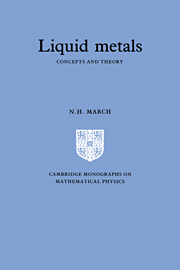Book contents
- Frontmatter
- Contents
- Preface
- 1 Outline
- 2 Pair correlation function and structure factor of ions
- 3 Thermodynamics
- 4 Electron screening and effective ion-ion interactions
- 5 Interionic forces and structural theories
- 6 Statistical mechanics of inhomogeneous systems and freezing theory
- 7 Electronic and atomic transport
- 8 Hydrodynamic limits of correlation functions and neutron scattering
- 9 Critical behaviour
- 10 Electron states, including critical region
- 11 Magnetism of normal and especially of expanded liquid metals
- 12 Liquid-vapour surface
- 13 Binary liquid-metal alloys
- 14 Two-component theory of pure liquid metals
- 15 Shock-wave studies
- 16 Liquid hydrogen plasmas and constitution of Jupiter
- Appendices
- References
- Index
10 - Electron states, including critical region
Published online by Cambridge University Press: 19 January 2010
- Frontmatter
- Contents
- Preface
- 1 Outline
- 2 Pair correlation function and structure factor of ions
- 3 Thermodynamics
- 4 Electron screening and effective ion-ion interactions
- 5 Interionic forces and structural theories
- 6 Statistical mechanics of inhomogeneous systems and freezing theory
- 7 Electronic and atomic transport
- 8 Hydrodynamic limits of correlation functions and neutron scattering
- 9 Critical behaviour
- 10 Electron states, including critical region
- 11 Magnetism of normal and especially of expanded liquid metals
- 12 Liquid-vapour surface
- 13 Binary liquid-metal alloys
- 14 Two-component theory of pure liquid metals
- 15 Shock-wave studies
- 16 Liquid hydrogen plasmas and constitution of Jupiter
- Appendices
- References
- Index
Summary
So far, one has assumed that the electron states in liquid metals can be described by the nearly free electron approximation. It seems unlikely that this can be true in the presence of strong electron-ion scattering, such as exists in (1) rare earth metals, (2) transition metals, and (3) even sp metals such as the heavy alkalis, as these are taken up along the coexistence curve toward the critical point (Chapman and March, 1988). Therefore, in this chapter, it is important to summarize a basic approach to the calculation of electron states in a framework that transcends the nearly free electron approximation.
Electron states in simple s-p metals
Following Edwards (1958, 1962; see also Cusack, 1963; 1987), Ballentine (1966; 1975) has employed the Green function formalism to make perturbation calculations of the density of states N(E) for Al and Zn, thereby allowing him to discuss the range of its validity and limitations and motivating more satisfactory calculations for Al and Bi.
As discussed more specifically later in this chapter, in order to study the electronic structure of a liquid metal, represented by a model of independent electrons interacting with a disordered array of ions, one should start from a fixed configuration of ions and then average over the ensemble of all possible arrangements of the ions. The Green function formalism as set up by Edwards (1958; 1962) allows the calculation of ensemble averages of physical quantities without ever calculating the wave functions for a specific ionic array. The summary of the Green function procedure below follows closely the account of Ballentine (1966; 1975).
- Type
- Chapter
- Information
- Liquid MetalsConcepts and Theory, pp. 121 - 146Publisher: Cambridge University PressPrint publication year: 1990

